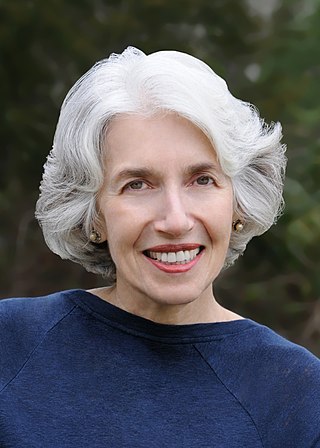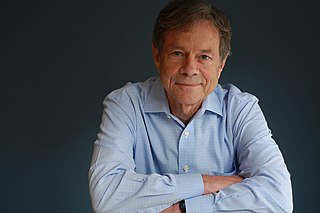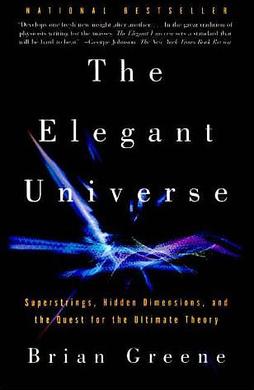Dennis Overbye (born June 2, 1944, in Seattle, Washington) is a science writer specializing in physics and cosmology and is the cosmic affairs correspondent for The New York Times . [1]
Dennis Overbye (born June 2, 1944, in Seattle, Washington) is a science writer specializing in physics and cosmology and is the cosmic affairs correspondent for The New York Times . [1]
Overbye received his B.S. in physics from M.I.T.—where he was a member of the Alpha Mu chapter of Phi Kappa Sigma—in 1966. He started work towards a master's degree in astronomy from U.C.L.A. in 1970.
Overbye started his career by working as a scientist for Boeing and then other companies. In 1976 he became assistant editor at Sky and Telescope magazine. From 1976 to 1980 he was a senior editor at Discover magazine. Subsequently, he embarked on a freelance career, during which time he published articles in Time , Science , the Los Angeles Times , and The New York Times , among other publications.
He has written two books: Lonely Hearts of the Cosmos, about scientists and their quest to understand the universe, and Einstein in Love, dealing with Albert Einstein's youth and the controversy surrounding the degree to which Einstein's first wife, Mileva Marić, contributed to the theory of relativity. [2] He joined the staff of The New York Times in 1998 as deputy science editor, then switched to full-time writing. In 2014 he was a finalist for the Pulitzer Prize for Explanatory Reporting. [3]
Overbye lives in New York City with his wife, Nancy Wartik, their daughter Mira Overbye and two cats.

Dava Sobel is an American writer of popular expositions of scientific topics. Her books include Longitude, about English clockmaker John Harrison; Galileo's Daughter, about Galileo's daughter Maria Celeste; and The Glass Universe: How the Ladies of the Harvard Observatory Took the Measure of the Stars about the Harvard Computers.

The Pulitzer Prize is an award administered by Columbia University for achievements in newspaper, magazine, online journalism, literature, and musical composition in the United States. It was established in 1917 by provisions in the will of Joseph Pulitzer, who had made his fortune as a newspaper publisher.

Alan Paige Lightman is an American physicist, writer, and social entrepreneur. He has served on the faculties of Harvard University and Massachusetts Institute of Technology (MIT) and is currently a professor of the practice of the humanities at the Massachusetts Institute of Technology (MIT).

Michio Kaku is an American physicist, science communicator, futurologist, and writer of popular-science. He is a professor of theoretical physics at the City College of New York and the CUNY Graduate Center. Kaku is the author of several books about physics and related topics and has made frequent appearances on radio, television, and film. He is also a regular contributor to his own blog, as well as other popular media outlets. For his efforts to bridge science and science fiction, he is a 2021 Sir Arthur Clarke Lifetime Achievement Awardee.

Brian Randolph Greene is an American theoretical physicist and mathematician. Greene was a physics professor at Cornell University from 1990–1995, and has been a professor at Columbia University since 1996 and chairman of the World Science Festival since co-founding it in 2008. Greene has worked on mirror symmetry, relating two different Calabi–Yau manifolds. He also described the flop transition, a mild form of topology change, showing that topology in string theory can change at the conifold point.

The Elegant Universe: Superstrings, Hidden Dimensions, and the Quest for the Ultimate Theory is a book by Brian Greene published in 1999, which introduces string and superstring theory, and provides a comprehensive though non-technical assessment of the theory and some of its shortcomings. In 2000, it won the Royal Society Prize for Science Books and was a finalist for the Pulitzer Prize for General Non-Fiction. A new edition was released in 2003, with an updated preface.

John David Barrow was an English cosmologist, theoretical physicist, and mathematician. He served as Gresham Professor of Geometry at Gresham College from 2008 to 2011. Barrow was also a writer of popular science and an amateur playwright.

Allan Rex Sandage was an American astronomer. He was Staff Member Emeritus with the Carnegie Observatories in Pasadena, California. He determined the first reasonably accurate values for the Hubble constant and the age of the universe.

Cosmology is a branch of physics and metaphysics dealing with the nature of the universe, the cosmos. The term cosmology was first used in English in 1656 in Thomas Blount's Glossographia, and in 1731 taken up in Latin by German philosopher Christian Wolff, in Cosmologia Generalis. Religious or mythological cosmology is a body of beliefs based on mythological, religious, and esoteric literature and traditions of creation myths and eschatology. In the science of astronomy, cosmology is concerned with the study of the chronology of the universe.
Natalie Angier /ænˈdʒɪər/ is an American nonfiction writer and a science journalist for The New York Times. Her awards include the Pulitzer Prize for Beat Reporting in 1991 and the AAAS Westinghouse Science Journalism Award in 1992. She is also noted for her public identification as an atheist and received the Freedom from Religion Foundation's Emperor Has No Clothes Award in 2003.

Deborah Blum is an American science journalist and the director of the Knight Science Journalism program at the Massachusetts Institute of Technology. She is the author of several books, including The Poisoner's Handbook (2010) and The Poison Squad (2018), and has been a columnist for The New York Times and a blogger, via her blog titled Elemental, for Wired.
Gareth Cook is an American journalist and editor. He was awarded a Pulitzer Prize in 2005 for “explaining, with clarity and humanity, the complex scientific and ethical dimensions of stem cell research.” Cook is a contributing writer for The New York Times Magazine, is also the series editor of The Best American Infographics and editor of Mind Matters, Scientific American's neuroscience blog. His writing has appeared in The New York Times Magazine, The Boston Globe, Wired, and Scientific American.
John M. Crewdson is an American journalist. He won a Pulitzer Prize for The New York Times, where he worked for 12 years. He subsequently spent 26 years in a variety of positions at the Chicago Tribune.

Robert P. Kirshner is an American astronomer, Chief Program Officer for Science for the Gordon and Betty Moore Foundation, and the Clownes Research Professor of Science at Harvard University. Kirshner has worked in several areas of astronomy including the physics of supernovae, supernova remnants, the large-scale structure of the cosmos, and the use of supernovae to measure the expansion of the universe.

William J. Broad is an American science journalist, author and a Senior Writer at The New York Times.
Cosmic Variance was a collaborative weblog discussing physics, astrophysics, and other topics, written by JoAnne Hewett, Mark Trodden, Sean Carroll, Risa Wechsler, Julianne Dalcanton, John Conway, and Daniel Holz. It was the successor to Carroll's earlier blog Preposterous Universe, which began in early 2004 and ran through much of 2005. The blog's name came from the cosmology concept of cosmic variance.

The American Institute of Physics (AIP) instituted their Science Writing Award to "promote effective science communication in print and broadcast media in order to improve the general public's appreciation of physics, astronomy, and allied science fields." The winner receives $3000, and an engraved Windsor chair. The award is given in three broad categories: 1) science writing, 2) work intended for children, and 3) work done in new media. The AIP stopped issuing awards to three categories: 1) work by a professional journalist 2) work by a scientist, and 3) broadcast media
Xu Liangying was a Chinese physicist, translator and a historian and philosopher of natural science.
Quanta Magazine is an editorially independent online publication of the Simons Foundation covering developments in physics, mathematics, biology and computer science.
LIGO is a 2019 American documentary film that tells the inside account of the discovery by the international LIGO Scientific Collaboration of the first observation of gravitational waves in September 2015, a discovery that led two years later to the Nobel Prize in Physics for LIGO physicists Rai Weiss, Kip Thorne and Barry Barish. In December 2019, National Geographic named the LIGO detections at the top of its list of "The 20 Top Scientific Discoveries of the Decade".